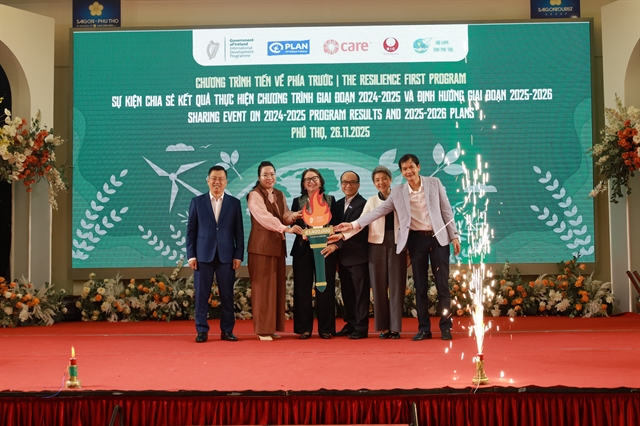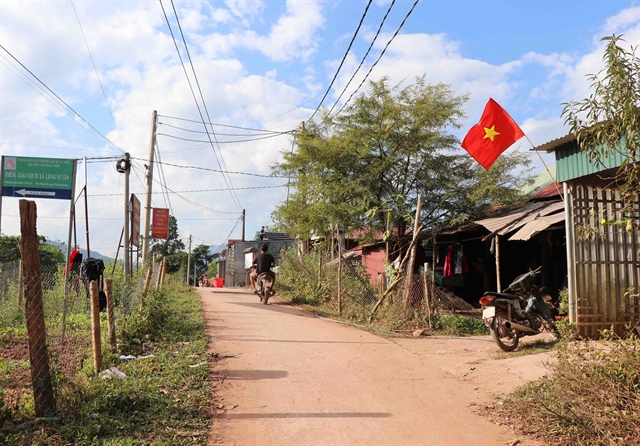 Society
Society


|
| A newly-built road in Leng Su Sìn Commune, northern mountainous Điện Biên Province. Investment in infrastructure is key to sustainable poverty reduction. — VNA/VNS Photo |
HÀ NỘI — Việt Nam is expected to lower its national average poverty rate from 58.1 per cent in 1993 to 2.75 per cent by the end of 2020, becoming a role model in the world in poverty reduction and hunger elimination, said Prime Minister Nguyễn Xuân Phúc.
He was speaking at a national online conference on Friday to review poverty reduction work in 2016-20.
Việt Nam is among 30 countries applying multidimensional poverty reduction criteria which include income, access to basic social services like healthcare, education, housing, clean water, hygiene and information.
In 2016-20, the country has mobilised VNĐ93 trillion (US$4.1 billion) for the national target programme on sustainable poverty reduction.
According to PM Phúc, during that period, the National Assembly and the Government spent 21 per cent of the State budget on social security, two times higher than the investment of the previous period and the highest figure among ASEAN countries. Việt Nam has also offered financial assistance sourced from the State budget for 13 million people affected by the COVID-19 pandemic.
“Poverty reduction is a social and humanitarian task of top importance. This is also an important socialist orientation of Việt Nam under the leadership of the Party,” he said.
All communes have roads for cars connected with the commune’s centre while 99 per cent of commune centres and 60 per cent of villages have electricity.
PM Phúc cited Hùng Lợi Commune, Yên Sơn District in the northern mountainous province of Tuyên Quang as an example of poverty reduction. Being 40km from Tuyên Quang City, the commune has 7,000 people and 70 per cent of the households are classified as poor. As of November 2019, about 280 people of the commune were working for Samsung and each of them sent VNĐ5 million to VNĐ6 million ($217-260) to their families each month.
Another example is from Trà Linh Commune, Nam Trà My District in central Quảng Nam Province. People who wanted to reach the commune used to have to walk nine hours. Since a road was built, it now takes drivers 30 minutes to travel from the province's centre to the commune.
Those examples show infrastructure and a favourable business and investment climate which helps create jobs for local people are the best solutions to sustainable poverty reduction, he said.
However, the PM also pointed out a number of challenges Việt Nam has to face.
He warned of unsustainable poverty reduction in many places, widening gaps between the rich and the poor as well as the risk of poverty relapse, especially in mountainous remote areas, ethnic minority areas and regions frequently hard-hit by natural disasters.
In many areas, the poverty rate remains more than 5 per cent and stands high among the ethnic minority community. On average, one of five poor households is a disabled family. Impacts from the COVID-19 pandemic have slowed and disrupted sustainable development progress.
Oxfam has estimated that half a billion people in the world or more than 8 per cent of the world’s population could be pushed into poverty due to COVID-19. “This is such a big challenge for global poverty reduction,” Phúc said.
The Government leader highlighted that one of the most important solutions to reduce poverty was to invest in infrastructure, create trade connections, education and job opportunities.
He ordered agencies to stick to the inclusive poverty reduction programme and adopt an investment plan for the national target programme on poverty reduction.
He noted that more attention must be paid to children, the elderly and ethnic minority communities to ensure no one is left behind. Ministries and sectors should prioritise State sources and call for private investment and support from international donors in poverty reduction work.
The PM pointed out that to solve poverty, it is necessary to start from production, business to create employment. Service agriculture development should be given priority, especially programmes focused on low-income areas. — VNS